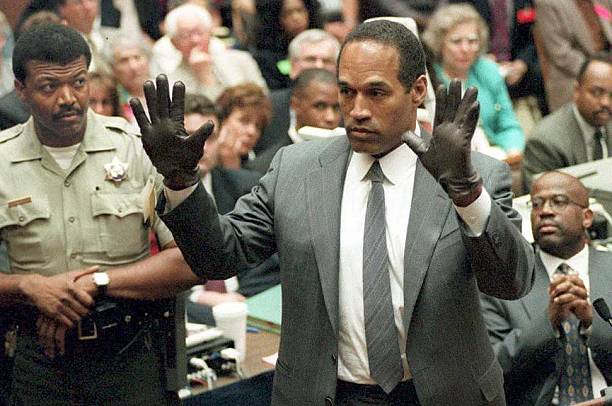(ThyBlackMan.com) As to the double murder case against O.J. Simpson, there was so much evidence that his guilt was obvious. This evidence included, but was not limited to, blood at the crime scene and on and in Simpson’s white Bronco; a bloody glove found at the crime scene and a matching glove found at Simpson’s home; a knit cap, with hair that resembled that of Simpson, found at the crime scene; footprints matching Simpson’s foot size found at the crime scene; blood found in Simpson’s home; blood on socks found in Simpson’s home; and the limo driver, scheduled to pick up Simpson on the night of the murder, buzzed Simpson’s intercom and got no response.

There was other evidence, including the infamous low-speed Bronco chase, not used against Simpson. Evidence was not used either because the prosecution elected not to use it, the judge refused to allow it, or certain things, like Simpson taking and flunking a polygraph, were inadmissible.
One piece of evidence not used was testimony from a witness named Jill Shively. On the night of June 12, 1994, Shively saw a white Bronco driving quickly and recklessly from near the scene of the crime and around the time of the crime. The driver of the Bronco nearly hit Shively’s car. When she learned about the murders, she called the police, described what happened, gave them the Bronco’s license plate and identified the driver as Simpson.
One would consider this a crucial piece of evidence placing Simpson near the crime scene on the night of the murders. Why did the prosecution choose not to use this eyewitness? Shively sold her story for $5,000 to one of the tabloids. Lead prosecutor Marcia Clark believed this tainted Shively’s credibility, and Clark decided against putting her on the stand to face cross-examination. Besides, the prosecution reasoned, there is so much evidence pointing to Simpson’s guilt, why bother with an iffy witness?
Simpson, without a lawyer present, was interviewed by the police the day after the murders. The detectives saw cuts on Simpson’s hands. Simpson claimed he sustained them “when I was rushing to get out of my house,” but in his pretrial deposition he claimed the cuts came from a glass he broke in anger when he heard about the death of his ex-wife.
The jury consisted of eight blacks. Given the jury’s unwillingness to apply reason and common sense, none of the evidence really mattered. Years after the trial, one of the jurors, a black woman named Carrie Bess, in an interview admitted she ignored the evidence.
Interviewer: Do you think there are members of the jury that voted to acquit O.J. because of Rodney King?
Bess: Yes.
Interviewer: You do?
Bess: Yes.
Interviewer: How many of you do you think felt that way?
Bess: Oh, probably 90% of them.
Interviewer: 90%. Did you feel that way?
Bess: Yes.
Interviewer: That was payback.
Bess: Uh-huh.
Interviewer: Do you think that’s right?
After that question, Bess just put up her hands and shrugged.
During the trial, an inner-city New Jersey high school teacher wrote an article called “Race, O.J., and My Kids.” It was published in a center-left magazine called The New Republic:
“No more than four of my 110 students (most of whom are black) think O.J. Simpson is definitely guilty and few are willing to admit the possibility that he might be. This faith in Simpson is strongest among black girls. …
“One student suggested that Ron Goldman killed Nicole before killing himself and then throwing away the knife. Another believes the dog did it. Shenia suggested that Al Cowlings, Simpson’s best buddy, did it. Bryant believes the killer is O.J.’s son. Philip blames ‘that (gay) dude who wants to marry O.J.’; that would be Kato Kaelin, Simpson’s houseguest. …
“Jon, a bright student, had his own scenario: O.J. was shaving and cut himself. Kato took the blood from the shaving cut, brought it to the crime scene and dumped it.”
What can one say other than this? O.J. Simpson has died. Ron Goldman and Nicole Brown Simpson were unavailable for comment.
Written by Larry Elder
Official website; http://www.larryelder.com

















Where did O.J. Simpson get the skills necessary to cut two people to death ? I also find it difficult to believe that one person ( i.e. O.J. ) could simultaneously detain two frightened potential victims of a horrible impending death. Why didn’t one, or both of the victims run away from O.J. in an attempt at saving their lives? This entire case can be said to be an example of the Russian author Count Leo Tolstoy’s” divine justice” ( i.e. exemplar in Tolstoy’s book ” Anna Karenina “).
The questions you raise about the O.J. Simpson case touch on some deeply complex issues regarding the physical and circumstantial aspects of the crime. The logistics of how one person could manage to control and fatally wound two others, especially under such frantic and high-stress conditions, are indeed perplexing and have been a point of debate and speculation.
As for the victims not being able to escape, various factors could have influenced this tragic outcome, including the element of surprise, physical constraints, or overwhelming fear.
Linking this case to Leo Tolstoy’s concept of “divine justice” from “Anna Karenina” introduces a philosophical layer to the discussion. Tolstoy often explored themes of morality and fate, and applying his ideas of divine justice to real-world events like this trial suggests a view that there might be unseen, metaphysical laws at play that influence human affairs and justice.
Mr. Washington; You are absolutely correct on all points raised to include your recognition of the metaphysics of “Christian ethics” which may also be referred to as “divine justice”( i.e. God’s justice )versus” human justice” ( i.e. the courts of the land ). Our courts sometime refer to our kind of justice as “a third party adversarial system” , but I believe, like Tolstoy, the believer in “divine justice”, inferred in his book titled ” Anna Karenina” that this system is overseen by a “supersedeus judge” ( i.e. God ) who gives the final judgement from which there isn’t an appeal ( i.e. the death sentence ). O.J. was not found guilty of committing the murders by a preponderance of the evidence presented in the court of man, and this conclusion was considered “justice”, but in the end, O.J., like Tolstoy’s Anna who threw herself beneath the wheels of a train, met death due to an incurable cancer.